A TRIP TO THE MOON
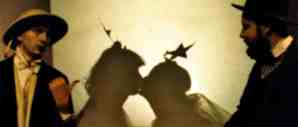
Show devoted to Georges Méličs and all who visited the
Moon and others - who wanted to do it: alchemists, astronomers, magicians and
madmen
Persons: Dr Hallucinni, Luna,
Two Astronomers: Alcofrisbas & Parafaragamus, Alchemist, Mefisto, Georges
Melies, Mr. Tvardovsky, Cyrano de Bergerac, Crazy Inventor, Selenits and many
others
Actors:
Katarzyna Gladyszek, Anna Lenczewska, Elwira Romanczuk, Jacek Milczanowski, Marcin
Popczynski, Hermes Trismegistos, Robert Zurek
Scenario, produced and directed by Wieslaw
Holdys
Set - scene by Jan Polewka
Costumes by Dorota Morawetz
Music
by Maurycy J. Kin - Wendesday Radio
Sound engineer - Malgorzata Teteruk
Assistant of production
- Kinga Piechnik
The performance is sponsored by Municipality of Cracow
![]()
FIRST NIGHT: 2002, October 26, Frankfurt / Oder - Kleist Forum, Magic - Net Annual Meeting
POLISH PREMIERE: 2002, Noveber 17, 18, Cracow, Groteska Of-Stage
|
Nearest shows coming soon: June 13th, 14th 2005; at 7:00 p.m Teatr Zależny Politechniki Krakowskiej, ul. Kanonicza 1, Kraków If you don't know where Theatre Zalezny is - click here for map |
"A TRIP TO THE MOON" is theatre performance with elements of film, ballet,
circus, musical and art of illusion. This kind of performance links to the
"fairy-theatre" and first steps of silent movie.
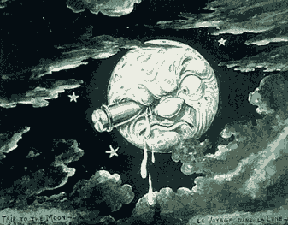
The work is derived from the
classic silent film from Georges Melies, which was the screens first science
fiction film. The film was only 14 minutes long, and was taken from the Jules
Verne story and the works of H. G. Wells. Georges Melies was a magician and
illusionist. He built the first studio dedicated to film production in 1897, and
in 1902 he produced, directed, stared in and created the sets and special
effects for "A Trip to the Moon". Coincidently, he filmed each scene as if it
were a stage play.
This is performance in 3 parts (but without break, total time about 60 min) - action of first part is in XVII-century , in alchemist workshop - and is about mystic trip to the Moon. We meet also people which were in this place - like Cyrano de Bergerac and Mr. Tvardovsky - Polish nobleman from Cracow. Second part is mainly inspired by Melies film and takes place in time of fin de siecle" - and it is trip to the Moon and landing on Silver Planet. Action of third part is in 1969 - back to the Earth and landed on the deep of ocean. You see that our performance is a travel in time machine also....
A short justification to "A Trip to the Moon"
On 21
August 1969 Neil Armstrong may have set foot as the first man ever on the rocky
surface of the silver globe, yet does that mean the dream of reaching the Moon
came true? Did travelling to the Moon, which started 1,800 years ago in ancient
Rome in the mind of Lucian of Samostata and lasted for centuries in the
imagination of writers, astronomers, alchemists, astrologists, painters and
magi, really end with the landing of Apollo 11? I have serious doubts. While
working on the play, I pursued thousands of pages featuring descriptions of
imaginary travels to the Moon and compared them with reports from actual trips.
For me the former ones were more interesting, as in this case imagination is
more curious than empirical experiences.
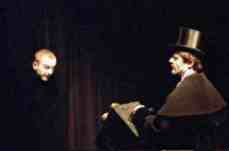 My main source of inspiration was
film, one of the most beautiful inventions made by man to make human dreams come
true. The beginnings of cinematic art are fantastic and beautiful. Especially at
the turn of the century, just after the Lumiere Brothers showed their invention
at Salon of India in Paris one hundred years ago. At that time the cinema was a
toddler, marvelling at its own magic and looking for the most suitable forms.
Most importantly, the cinema was silent. During the infancy of the cinema George
Mélies legend came to fore. He was the owner of a small illusion theatre and the
first creator of cinematic fantasies. A Trip to the Moon in 1902 is most widely
known as the first science fiction film in history.
My main source of inspiration was
film, one of the most beautiful inventions made by man to make human dreams come
true. The beginnings of cinematic art are fantastic and beautiful. Especially at
the turn of the century, just after the Lumiere Brothers showed their invention
at Salon of India in Paris one hundred years ago. At that time the cinema was a
toddler, marvelling at its own magic and looking for the most suitable forms.
Most importantly, the cinema was silent. During the infancy of the cinema George
Mélies legend came to fore. He was the owner of a small illusion theatre and the
first creator of cinematic fantasies. A Trip to the Moon in 1902 is most widely
known as the first science fiction film in history.
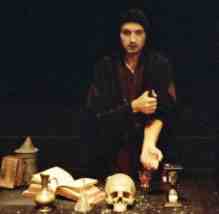 I suspect George Mélies had a secret
connection with the ghosts of alchemists, and just like them, he was looking for
the philosophers' stone, which is potent enough to transform the substance of
paper, cloth, wood and celluloid into the gold of illusion.
I suspect George Mélies had a secret
connection with the ghosts of alchemists, and just like them, he was looking for
the philosophers' stone, which is potent enough to transform the substance of
paper, cloth, wood and celluloid into the gold of illusion.
I wish to
capture the atmosphere of cinema's infancy. I consider the moments when out of a
village-fair performance of theatre during magical séances the first films were
born as being most important.
George Méličs called one of his filmsAn
Impossible Voyage. It is my strong belief that theatre is such a voyage,
just like travelling to the Moon. Reaching his destination, Neil Armstrong found
a stony, human-unfriendly surface without an atmosphere or water, whereas George
Méličs discovered the Moon's inhabitants, the Selenites, who were very
interested in these terrestrial creatures. I wonder, whom and what Teatr Mumerus
will meet on reaching the destination of its theatrical trip to the Moon?
Wieslaw Holdys
"So I thought about reaching the Moon in such
a way as to enable staging some original and funny fairy-tale pictures on and
inside the Moon, at the same time adding one or two artistic effects (maidens
representing stars, comets etc.; snow effects, sea bed etc.)."Georges
Melies
"- Professor Hallucini, rumour has it that you happen to
be Mephistopheles and Georges Méličs in one. You are said to have burnt your
films and drowned some in the Seine?
- Not all of them. The ones I
coloured manually,An Impossible Voyagefor example, I sold to be made into
combs. I also was Lucian of Samostata, Münchausen, Jadviga Luszczevska called
Deotyma, Hans Pfaal and Edgar Allan Poe in one, Polish Nobleman Tvardovsky from
Cracow, Julius Verne and Cyrano de Bergerac. Later I received a League of Honour
distinction as well as sold toys and sweets at the station of Montparnasse."
Wieslaw Holdys, text from the scenario of "A Trip to the Moon"
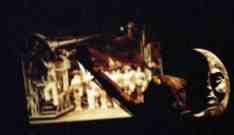 " A theatre without its own
ensemble is called a receiving theatre in English. From Thursday through
Saturday not only the Kleist Forum, but rather the whole of Frankfurt received a
lot during "Magic Love", a meeting of theatres that took place on both sides of
the river Oder. Mainly the young people had the opportunity of seeing
unconventional theatre productions such as "Urfaust" by the caroussel Theater
Berlin and "A Trip to the Moon" by Teatr Mumerus from Krakow. (...)
" A theatre without its own
ensemble is called a receiving theatre in English. From Thursday through
Saturday not only the Kleist Forum, but rather the whole of Frankfurt received a
lot during "Magic Love", a meeting of theatres that took place on both sides of
the river Oder. Mainly the young people had the opportunity of seeing
unconventional theatre productions such as "Urfaust" by the caroussel Theater
Berlin and "A Trip to the Moon" by Teatr Mumerus from Krakow. (...)
Wieslaw
Holdys, director of Poland's Teatr Mumerus, came right to the point: "Language
is not the only form of theatrical expression." His production was inspired by
George Melies film from 1902, which is the first science fiction film ever, a
cross-section about dreamers and travellers to the Moon throughout the years.
Most of the time, he relies upon the strength of imagery and expressive
pantomime. The work, which originated from many years' of reading material on
travelogues, had its world premiere on Saturday."
Katrin Lechler,
Norwegian coolness and Russian melancholy
MOZ, October 28,
2002
Special thanks to:
Barbara Luszczynska - University of
St. Luis, USA
Jerzy Zon - Teatr KTO, Cracow
Adolf Weltschek - Teatr
Groteska, Cracow
Dirk Neldner - Magic Net leader, Berlin
Elisabeth Kahn
- Magic Net coordinator, Berlin
And to
TRIGONOMEXER VORTEX

2 .TEATR GROTESKA - GROTESKA OF-STAGE, CRACOW PL

3. STOWARZYSZENIE TEATRÓW NIEISTYTUCJONALNYCH - STEN, CRACOW PL

* * *








"A TRIP TO
THE MOON"- click to enlarge
If you want to watch a slides from performance, click here
* * *
A TRIP TO THE LAND OF THE IMPOSSIBLE
What do we know about the Moon? A lot. We know the geological structure of the Silver Globe. We have named its seas and mountains. Thanks to the photographs taken during the landing on the Moon, we know its exact appearance. Chemistry, physics, astronomy, and other branches of science explain, describe, and elucidate... And yet it still remains mysterious, cool, and unconquered. For centuries man has dreamed of setting foot on it, speculating about the appearance of the Moon's inhabitants and of the Moon itself. The history of its conquest is also the history of a certain dream born in the minds of philosophers, in the workshops of alchemists, in the Universities, and also in the imaginations of artists.
Wieslaw Holdys actually devoted his spectacle "A Trip to the Moon" to one of them - Georges Melies. This great magician of the cinema created in 1902 his "A Trip to the Moon", noted as the first science fiction picture. Since everything is possible in the theatre, as in the cinema, nobody need be surprised the Monsieur Melies appears on the stage of the Groteska Theatre in order to invite us, as the Master of Ceremonies, to a trip through centuries. We start from an alchemist's workshop in which dreams of the impossible were given the imprint of magic and science. After a while, we land at a fair with a dell'arte Cyrano de Bergerac giving an account of his trip to the Moon. We participate in the birth of the cinema. Finally, we board, together with Melies' characters, the rocket which will immediately land on the planet. Even though at the end of this space revue we see on the screen the American astronaut on the Moon and the true face of the Silver globe, there are no doubts: the vision of Melies and all those who travelled to the Moon in their imagination is more interesting.. This in fact seems to be the most valuable reflection after viewing this spectacle, which, also thanks to the five actors (Katarzyna Gladyszek, Elwira Romanczuk, Jacek Milczanowski, Marcin Popczynski, and Robert Zurek) embodying several characters, is quite an agreeable show, although it is not always clear "what the author is driving at". In terms of the magical stage design of Jan Polewka and the costumes of Dorota Morawetz, Wieslaw Holdys' "A Trip to the Moon" represents yet another fulfilment of the dream of a trip to the land of the impossible.Magda Huzarska
Gazeta Krakowska, 22. 11. 2002
Translated from Polish: Andrzej Grzybowski
* * *
To the Moon without a Spacesuit
A hundred years after Georges Melies' Trip, another madcap, Wieslaw Holdys, set out for the Moon - at the premiere of the spectacle at the Cracow Mumerus.
Wieslaw Holdys, a director who graduated from the Cracow Theatre School and the creator of spectacles such as " Conversation of Master Polycarp with Death" which received an award at the at the Festival of Classics in Opole, or " The Baroque", decided three years ago that ordinary theatre is not enough and founded an association called the Mumerus Theatre. (...)
Holdys might be called a theatrical historian of beating one's head against the wall. Rummaging in hundreds of old texts and messages, he creates theatrical collages, which serve to praise Man's Sisyphean efforts to understand and embrace the world or at least to assimilate it. In his view, fantasy and imagination serve best the last aim.
The latest premiere at the Mumerus is that of "A Trip to the Moon". Georges Melies' film, created in 1902, about two daredevils shot off in a rocket to our satellite, bears the same title. The creator of the film is regarded as a pioneer of cinematic fantasy. At a time when it was not believed that an audience could watch one film for as long as 15 minutes, he showed "A Trip..." and achieved a success.
However, a dozen or so years later Melies, the creator of 500 (or as some claim 4000) films, became a bankrupt and was forgotten. At the end of the 1920s he was rediscovered by the Surrealists. Nevertheless he preferred to remain in his new employment - selling candy in a railway station kiosk.
Maintained within the framework of the poetry of surrealism, Holdys' spectacle is a series of amusing and moving stage images in which fantasy and fiction are intertwined with Melies' biography and the history of Man's endeavours to reach the Moon. However, most attention is devoted to the expedition of the protagonists of "A Trip..." who meet during their flight enticing little stars with feminine shapes and, on landing, strike an anthropomorphic Moon directly in the eye.
Projected frames from his film and the stage images inspired by them constitute a direct form of homage to Melies. The stage designer Jan Polewka and Dorota Morawetz, the creator of the "astral" costumes representing a delicate pastiche of the original film designs, contributed much to the generation of the poetical aura of non-literal but perceptible connotations.
There are few words in this theatre which preaches the greatness of the silent film. Anyway many of them appear in the inscriptions moving about the stage together with the actors. Holdys reproduces the magic of the old cinema - film tricks, discovered by the first magician of the screen find their own comical theatrical parallels.
In this spectacle, Holdys' attitude to Man's actual landing on the Moon, achieved by the Americans, is the same as that to the discovery of sound in the cinema. It is no "great step in the history of mankind" but a vulgar episode which moves nothing forward and represents only an apparent argument in support of the thesis that everything can be rationally explained, proved and embraced in words and numbers. The creator of the Mumerus asserts that this is not so and bows deeply to Melies who reminded people that what can be glimpsed on the other side of the mirror is always of greatest interest to the artist.Marek Mikos
Gazeta Wyborcza, 22.XI.2002
Translated from Polish: Andrzej Grzybowski
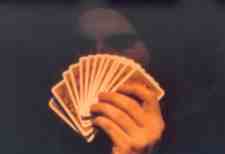

|
[Strona główna]|[Wydarzenia][Krótko o nas]|[Repertuar]| [Spektakle]|[Nasz Zespół][STEN][Edukacja]|[Przydatne cytaty]| [Main Page]|[Briefly about us]|[Repertoire]|[Our Team]|[Events]
|
© 2000Wiesław Hołdys
Wszelkie prawa autorskie zastrzeżone.
ostatnie zmiany -24-03-2005- last update